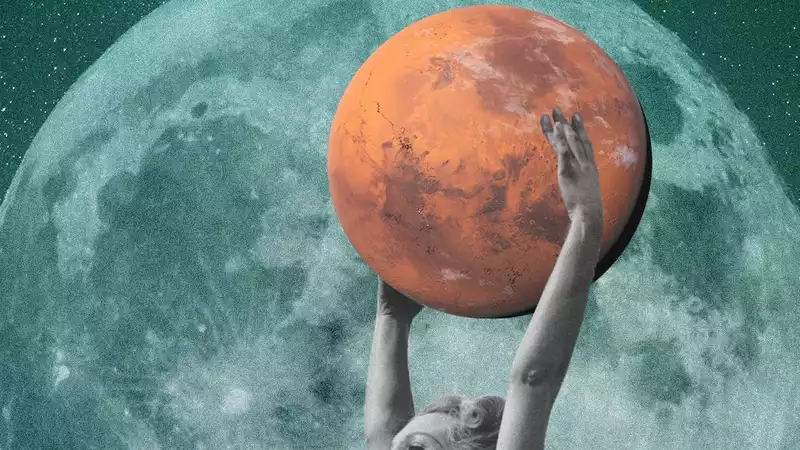Mars needs women.
The 1968 low-budget science fiction film opens with an ominous broadcast of aliens heading toward Earth.
Earth's best scientists are now working on moving Mars in the opposite direction. In the process, they are testing the theory that women may be the most efficient option for colonizing the Red Planet. Simulation Complex (HI-SEAS) recently completed a month-long, women-only mission simulation to test what life would be like for such a crew in a place only a Mars rover has ever been. Located approximately 8,200 feet above sea level in the Mauna Loa Mountains on the Big Island of Hawaii, the HI-SEAS habitat is a 1,200-square-foot dome that stands atop rocks and lava of Mars-like geology. Several long-term (4-month to 1-year) simulation missions have already been conducted by NASA and various private research groups.
The Red Planet is 249 million miles or about eight months (by rocket) from Earth, so all the resources on board and in the Martian soil are valuable. Weight is the enemy of rocket launches and proposed long space trips, and the needs of resources, equipment, and crew are always balanced against the physical balance of fuel supply. A ship bound for Mars requires sufficient fuel, even for a one-way trip.
The crew of the HI-SEAS Mars mission simulation is all female, from left to right: Beth Mundo, Dr. Michaela Musilova, Amanda Knutson, Dr. Brandi Nunez, Richelle Gribble, Chelsea Goad
In general, women eat and drink less than men and often weigh less, and therefore consume less oxygen. NASA scientist Jeffrey Landis, an expert in power sources and propulsion, describes the case of female Mars crews in a research paper published in the Harvard University archives. On average, women have less mass, less volume, and use proportionally less consumables than men.
But it is not only physical characteristics that make women suitable for Mars missions. Landis suggests that they would do better confined to a small space for months on end en route to a new planet. "In addition," Landis writes, "sociological studies show that female crews have a favorable dynamic in interpersonal relationships and are more likely to choose a nonconfrontational approach to solving interpersonal problems.
"On a mission like this, you will see strangers becoming family," says Dr. Mikaela Mushirova, director of the HI-SEAS mission that led the latest simulation. An astrobiologist who studies life in extreme environments, she has led 30 such simulation expeditions and found no change in efficiency between female-only and mixed-gender missions. With female-only crews, however, she says They were united and sharing faster than the mixed-gender crews I commanded." Male-only crews generally focus on "direct problem solving" and are "more hands-on," she says.
In the latest HI-SEAS simulation, Musilova and six other women from a variety of backgrounds and professions were assembled as "analog astronauts." To explore what such a versatile group of women could bring to life on Mars, the group's companions went beyond the world of STEM and included a pair of scientifically minded musicians: Chelsea Goad, a space and science writer, and Dr. Brandi Nunez, a microbiologist and veterinarian. In addition to the musicians, Dr. Sian Proctor, an earth scientist and professor who has worked on simulations in Poland and Utah in addition to two at HI-SEAS; Amanda Knutson, an active duty Air Force member who calls herself "Astronaut Hopeful" on Instagram; science communicator and podcast host Beth Mundo, and artist, curator, and gallerist Richelle Gribble.
Gribble says that by selecting such a diverse group of women, they are examining what people from different backgrounds bring to problem solving and activities that are integral to their daily lives. Podcasters regularly sent out "home broadcasts" from the simulation. Gribble created artwork. Past missions have compared food systems (packaged instant food vs. preservable food) and collected data on cohesion and performance, power and water use.
Proctor values the opportunity to put women at the forefront of spaceflight and challenges the notion that astronauts can only come from the STEM world. She believes that this "artistically heavy" women-only mission will overturn the notion of who can go to space. She says, "Simulations like this give us the opportunity to think about what other professions, like artists, bring to the table when trapped together." 'The idea is to explore how different skill combinations can benefit the crew and see what works best.'
"There is an argument that women-only crews make a huge difference in resources," Proctor says.
"Missions like this will better inform the decisions that are made before we finally go to Mars."
As the mission's second-in-command, Gribble's responsibilities include checking on all ongoing projects in the habitat that simulate life in space. The mission assumes that the crew has already arrived on Mars after a long space trip; daily life on HI-SEAS will be a mix of activities necessary for survival, such as growing food and purifying water, and personal projects that explore the diverse skills the women will bring to the distant world. to the distant world.
Gribble witnessed how the women learned to support each other in solving problems. She says, "The universe provides new challenges, as every task brings new problems." 'As we work together, this mission has given us the opportunity to explore what everyone brings to the table in the future of women in space.' I think the most important opportunity that comes from this mission is for other women to put themselves in our shoes."
.






Comments